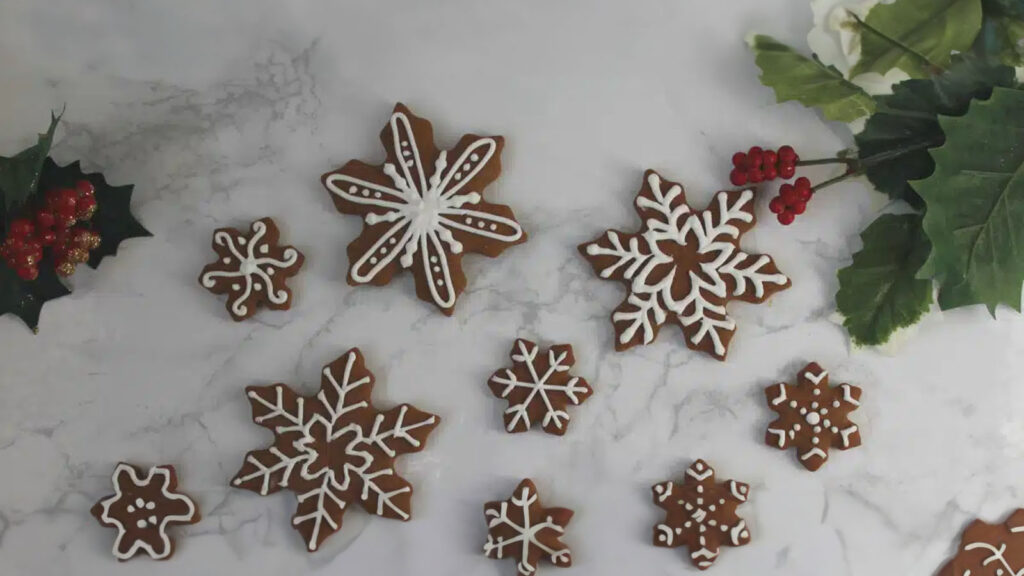
Ginger root was first cultivated in ancient China, where it was commonly used as a medical or ceremonial treatment. The first known recipe for gingerbread came from Greece in 2400 BC. Chinese recipes were developed during the 10th century and by the late Middle Ages, Europeans had their own version of gingerbread. From there it spread to Europe via the Silk Road. During the Middle Ages, it was favored as a spice for its ability to disguise the taste of preserved meats. Henry VIII is said to have used a ginger concoction in hope of building resistance to the plague. Gingerbread arrived in the New World with English Colonists.
Gingerbread has been around for a very long time. It would be cut into many different shapes and baked for pretty much all occasions. But in the 16th century Queen Elizabeth I is credited for the gingerbread man. She had her own gingerbread maker and had him make gingerbread in the shape of and decorate them in the likeness of her visiting dignitaries. They’re also said to have been made by folk medicine practitioners as a sort of “love potion”.
The spices in gingerbread are rich and warm. These include molasses, dark brown sugar, cinnamon, cloves, allspice, and of course ginger. The recipe that I am going to share with you included orange juice and orange zest. This made a delicious pairing with the warm flavors.
Gingerbread houses originated in Germany in the 16th century and gained popularity about 300 years later after the Brothers Grimm published their story “Hansel and Gretel” in 1812. The witch’s house was made of gingerbread and decorated with candy.
In 2019, I visited Mount Vernon, home of George and Martha Washington, in Virginia. This gingerbread recipe is known as Lafayette Gingerbread and is attributed to George Washington’s mother, Mary Ball Washington, who is said to have served it to the Marquis de Lafayette when he visited her in Fredericksburg toward the end of her life. This gingerbread came to be called Lafayette Gingerbread, in honor of the beloved French general. I love the flavor of this gingerbread. It is a bit smoother in flavor than typical gingerbreads. The orange hint is delicious. This is a dense gingerbread but is deliciously eaten warm with whip cream. This recipe and flavor would be a wonderful way to welcome carolers to your home or a delightful way to end a wonderful evening of trimming the tree. As many of you know, I like bare-bone ingredient recipes and this one is one of those. Enjoy!!
Instructions:
Yes! But also, no. There are some gingerbread cookie recipes that are soft, more like a gingerbread sugar cookie. And while these are great, they’re not suitable for gingerbread houses. Make sure your recipe produces a harder, crispy cookie and you should be just fine to make houses with it. The recipe I’ve shared below is great for both cookies and houses.
Yes, you can eat your gingerbread houses after they’ve been decorated and have been sitting for a while. But it’s all up to you, really. It won’t make you sick to eat them unless they’ve been contaminated somehow. They’ll just dry out and maybe get a little dusty. If you’re okay with that, I say go for it. Otherwise, just have it around as a decoration.
The term gingerbread is an old French word, which actually means, preserved ginger. The root was first cultivated in ancient China and it was eventually discovered that it helped to preserve both flour and meat.
I think we all know the story of the gingerbread man. It was one of my favorites in elementary school and still is today. But as a little refresher, a man and a woman couldn’t have children, so the woman baked a gingerbread boy (or man). When he came out of the oven, he jumped up and ran out the door saying, “Run, run as fast as you can. You can’t catch me. I’m the gingerbread man.” He ran into the forest and came upon several different animals that wanted to eat him, but he just kept running. Finally, he came to a fox who told him that he didn’t think he looked delicious at all and while the gingerbread man stood there stumped, the fox gobbled him up. The moral is: Be careful who you trust.”
Directions:

Kitchen Kneads is your one-stop shop for quality grains, flour, kitchen appliances, and other ingredients.
We are Utah’s premier baking and cooking resource!
Questions?


Kitchen Kneads is your one stop shop for quality grains, flour, kitchen appliances and other ingredients. We are Utah’s premiere baking and cooking resource! Questions?
888-881-9957
info@kitchenkneads.com
2022 | Kitchen Kneads | All Rights Reserved | Privacy Policy | Terms | XML Sitemap | Site by PDM